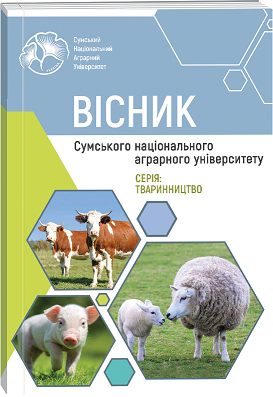Reproductive functions of sows of different genotypes and their descendants
Abstract
New technologies of pork production in most farms are associated with the emergence of significant amounts of stress and the development of immunodeficient conditions in young animals. When stress occurs, the tension of all body systems. To solve the tasks we studied the reproductive ability of sows, determined the own productivity of domestic and foreign breeding boars, determined the resistance to stress by the method of "formalin spot", conducted ethological studies and determined hematological and biochemical parameters of boars blood is determined. Therefore, it is very important when raising pigs is to calculate the ability to adapt to technological stress. It was found that the nest weight at 28 days was dominated by pigs of the second experimental group over the control and first experimental groups, respectively, 7.6 and 11.4 kg (p <0.05). According to the indicators of own productivity of pigs, namely for the age of achieving live weight, the first experimental group prevailed over the control group for 5 days. The average daily gains were also higher in the pigs of the first experimental group and prevailed in the control and second experimental groups by 4.71% and 2.75%, respectively (p <0.01). Similarly, when determining the live weight of boars, the first experimental group prevailed over the control and second experimental groups at the age of 100 kg at 4 and 2 days, respectively, and boars of the first experimental group had higher average daily gains of 2.6% and 1.2 % than analogues. When determining the adaptive characteristics of boars by the "formalin spot" method, the lowest number of stress-sensitive boars was found in the first experimental group (4%) than in the control and second experimental groups by 4 and 8%, respectively. According to ethological indicators, it was found that boars of the second experimental group had lower rates of active behavior (by 2.2% and 4%.) And prevailed in terms of sleep and rest by 16.7% and 8.7%. Indicators for eating food were lower by 22.15% and 22.7% than their peers.
References
2. Reshetnykov, A. O. and Demchuk, M. V., 2008. Hematolohichni doslidzhennia svynei vidhodivelnykh hrup z riznym koefitsiientom emotsiinosti [Hematological studies of pigs in fattening groups with different emotional coefficients]. Naukovyi visnyk LNUVMBT imeni S.Z. Hzhytskoho, no. 2 (37), рр. 231.
3. Ivanov V. O. and Voloshchuk, V. M., 2009. Biolohiia svynei [Biology of pigs]. Navchalnyi posibnyk. Kyiv: ZAT «Nichlava». 304.
4. Eidrehevych, E. V. and Raevskaia, V. V., 1978. Ynterer selskokhoziaistvennыkh zhyvotnыkh [Farm animals interior]. Moskva: Kolos, рр. 255.
5. Smyrnov, V. S., 2004. Vosproyzvodstvo y adaptatsyia svynei [Reproduction and adaptation of pigs]. Svynovodstvo, no. 6, рр. 27-28.
6. Smyrnov, V. S.. 2003. Otsenka adaptatsyy svynomatok k yntensyvnomu vosproyzvodstvu [Assessment of the adaptation of sows to intensive reproduction]. Zootekhnyia, no. 7, рр. 22-25.
7. Vitaly Bekenev, Arlene Garcia and Vyacheslav Hasnulin, 2015. Adaptation of Piglets Using Different Methods of Stress Prevention, Animals (Basel), no. 5(2), рр. 349–360.
8. Tolokontsev, A. Y., 2011. Produktyvnost svynomatok porodы diurok v riade pokolenyi pry napravlenoi selektsyy [Productivity of Duroc sows in a number of generations with targeted breeding]. Svynovodstvo, no. 3, рр. 26-28.
9. Serenius, T. K., Stalder, T. K. Bass J. W., 2006. National pork producers council maternal line national genetic evaluation program: a comparison of sow longevity and trait associations with sow longevity []. Anim. Sci., 84, рр. 2590-2595.
10. Frydcher, A., 2011. Mezhporodnoe skreshchyvanye povыshaet produktyvnost [Crossbreeding increases productivity]. Zhyvotnovodstvo Rossyy, no. 6, рр. 31-32.
11. Khalak, V.I., 2009. Adaptatsiia ta vidtvoriuvalna zdatnist svynomatok velykoi biloi porody riznoho pokhodzhennia [Adaptation and developmental health of sows of the great breeder breed]. Visnyk Sumskoho natsionalnoho ahrarnoho universytetu, no. 10, рр. 126-130.
12. Tsereniuk, O.M, Khvatov, A.I. and Stryzhak, T.A., 2010. Efektyvnist selektsiinykh i otsinochnykh indeksiv materynskoi produktyvnosti svynei [Efficiency of selection and evaluation indices of maternal productivity of pigs]. Naukovo-tekhnichnyi biuleten. Kharkiv, no. 102, рр. 173-181.
13. Ehiobu, N. G. Kyado, J.A. and Njike, M.C., 2000. Productivity of Large White, Hampshire breeds and their crosses at NAPRI Swine herd, Otukpo, Benue State. Journal of Agriculture Technology and Education. Vol. 5, рр. 21-28.
14. William McBride, Nigel Key, 2013. Hog Production From 1992 to 2009 : Technology, Restructuring, and Productivity Growth. Economic Research Report, no. (ERR-158). рр. 8
15. Lykhach, V. Ya., 2016. Obhruntuvannia, rozrobka ta vprovadzhennia intensyvno-tekhnolohichnykh rishen u svynarstvi. Monohrafiia. Mykolaiv. рр. 173-174.
16. Heber, L., 2010. Pork and carcasses quality in swine exploited in family farms. Animal Science and Biotechnologies. no. 43 (2). рр. 406-408.
17. Ahapova, Ye.M., Reshetnichenko, O.P., 1996. Pokaznyky krovi svynei riznykh henotypiv zviazok iz shvydkistiu rostu. Svynarstvo. no. 52.

 ISSN
ISSN  ISSN
ISSN 



